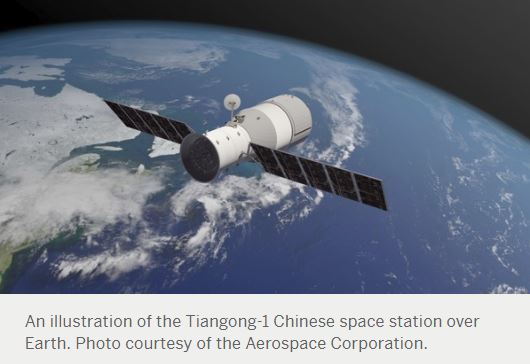
As the guessing game ramps up over where pieces of an out-of-control Chinese space station could fall to Earth this weekend, the answer to when it will drop got a little clearer.
The European Space Agency updated its prediction today, saying Easter Sunday is the best bet for the 8.5-ton Tiangong-1 to plunge into the Earth’s atmosphere. Specifically, later in the day on Sunday.
As always, they are couching this time frame. “This is highly variable,” the agency said in its update. “At no time will a precise time/location prediction from ESA be possible.”
Earlier estimates had given a wide window for when the defunct space station the size of a school bus would fall to Earth. Scientists have said most of it is expected to burn up on reentry, but not all of it. Chunks weighing up to 220 pounds could hit the ground or fall into the ocean.
So why did the impact window narrow? The solar wind.
“A high-speed stream of particles from the Sun, which was expected to reach Earth and influence our planet’s geomagnetic field, did, in fact, not have any effect, and calmer space weather around Earth and its atmosphere is now expected in the coming days,” the ESA said.
“This means that the density of the upper atmosphere, through which Tiangong-1 is moving, did not increase as predicted (which would have dragged the spacecraft down sooner) and hence the ESA Space Debris Office has adjusted the predicted decay rate.
“This implies that the new (and still uncertain) reentry window has shifted to later in the day on 1 April.”
As for where it will fall, that band of possibility has not narrowed in the last day. Scientists say debris could fall anywhere on Earth, roughly between the latitudes 43oN and 43oS.
Southern Lower Michigan is included in that possible debris area.
On Thursday, Gov. Rick Snyder announced Michigan was activating its Emergency Operations Center to monitor Tiangong 1’s reentry.
Regions with higher chances of seeing debris include northern China, central Italy, northern Spain, the Middle East, New Zealand, Tasmania, South America, southern Africa and northern states in the U.S., the ESA and U.S.-funded Aerospace Corporation have said.
China’s first space station has had a nearly seven-year run. It was launched in September 2011.
It was designed to be a manned lab, has two modules, including sleeping space for two astronauts, according to the Aerospace Corporation. There have been two manned missions to visit the space station, one in 2012 and another in 2013.
One of those missions included China’s first woman astronaut.
Two years ago, China said it had lost telemetry services with Tiangong-1, the Aerospace Corporation said. Shortly after that, trackers said it had gone into an uncontrolled orbit.
China initially said they expected the space station to fall in late 2017, then later revised the estimate.
Media in this post courtesy of mlive. Tune into our local and state newscasts, anytime day or night, for this story and more.
#wlenradio #wlennews #lenaweenews
